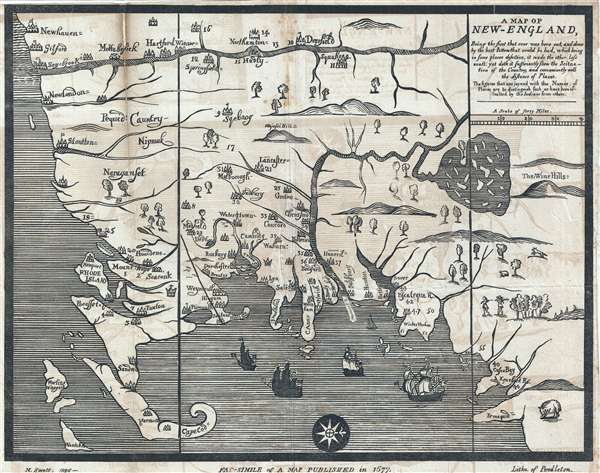This item has been sold, but you can get on the Waitlist to be notified if another example becomes available, or purchase a digital scan.
1826 / 1677 Pendleton / Foster Map of New England
NewEngland-pendleton-1826
Title
1826 (dated) 12 x 15.5 in (30.48 x 39.37 cm) 1 : 850000
Description
Foster prepared the map for issued in Reverend William Hubbard's 1677 Narrative of the Troubles with the Indians in New-England, the earliest accurate account of King Philip's War (1675-1678). King Philip's War, also known as the Frist Indian War, was fought between American Indians in present-day New England and English colonists over land and guns. The towns on this map that have a numerical reference are those that were attacked by the American Indians.
Although this is an 1826 facsimile of the original map, it is important in its own right. It was issued to illustrate the 1826 expanded John Davis 5th edition of Nathaniel Morton's New England's Memorial. The map one of the first prepared by Moses Swett and published by John and William Pendleton, an important American lithographic firm.
CartographerS
Pendleton's Lithography (1825 – 1836) was an American lithography firm active in Boston during the early 19th century. The firm was founded by brothers John and William S. Pendleton. Little is known of John, but William apparently moved to Boston from Montreal, Canada with Alexander McKenzie, a copper plate engraver. The two set up business with Abel Bowen from about 1820 to 1825. Around this time John Pendleton entered the picture. He and William purchased some lithographic tools from a Boston merchant named only Thaxter, who apparently acquired them in Europe but did not understand their use. The Pendleton's subsequently became the first lithographers in Boston. Their work was respected for portraiture, landscape prints, music covers, and other illustrations. Among William Pendleton's apprentices are the famous 19th century lithographers Benjamin F. Nutting and Nathaniel Currier (of Currier and Ives). John Pendleton retired from the firm in 1828, but it continued to operate under William. William, in turn, sold the firm to his bookkeeper, Thomas Moore, who changed the name but maintained the same business practices. In 1840, Moore sold out to Benjamin W. Thayer. Pendleton's Lithography was based in three separate locations in Boston: Harvard Place (1825-1826), Graphic Court (1826-ca.1832), and finally Washington Street (ca.1836). More by this mapmaker...
Moses Swett (1804 - December 20, 1838) was an American artist, lithographer, and draughtsman. Swett worked for a time with the Pendleton Lithography firm of Boston before relocating in 1830 to Baltimore and partnering with George Endicott to found Endicott and Swett, located in Graphic Hall. In 1831 the partners relocated again, this time to New York City. The partnership dissolved in July of 1834, and Swett began to publish independently in New York. In 1837, he relocated to Washington D.C. where he issued several political cartoons. Swett returned to Boston in 1838 where he died of unknown causes on December 20. Learn More...

